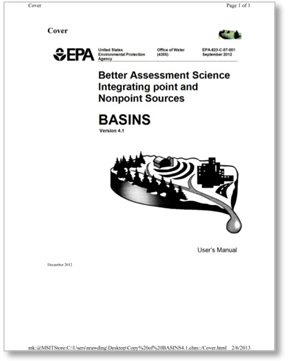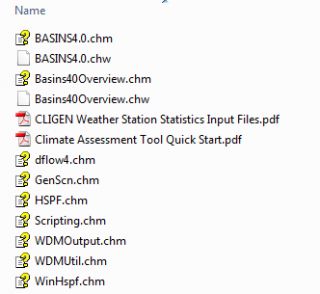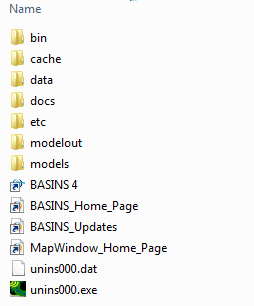BASINS User Information and Guidance
BASINS is free and available to anyone to download and use for any purpose. This page provides links to guidance on how to use BASINS, including the User’s Manual, tutorials and training, technical notes, case studies, and publications that highlight the use of BASINS in various watershed analyses.
On this page:
- BASINS User Manual
- BASINS Tutorials and Training
- BASINS Technical Notes
- BASINS Case Study
- BASINS Publications
- Additional Information
BASINS User Manual
BASINS is free and available to anyone to download and use for any purpose. This page provides links to guidance on how to use BASINS, including the User’s Manual, tutorials and training, technical notes, case studies, and publications that highlight the use of BASINS in various watershed analyses.

The BASINS User Manual provides an overview of the features and capabilities of BASINS, along with information on how BASINS works. In addition to information on the models, tools, and functions of BASINS, the User Manual provides the following information:
- Details of previous versions of BASINS
- Tutorial
- FAQs
- Full list of BASINS Data products
- Information on Weather files
The BASINS Core Manual is a good place to begin learning about BASINS, and can be downloaded on this page, or accessed from the BASINS help menu.
Also, user manuals are available for several models (if corresponding plugin is installed) and tools included in BASINS. These manuals are located in the BASINS folder installed on your computer’s disk drive in the \BASINS\Docs folder. The image below shows the location of the “docs” folder within the BASINS folder on your computer.


BASINS Tutorials and Training
EPA has developed a series of lectures and exercises on how to use BASINS for water quality modeling and watershed assessment. The lectures follow sequentially. Companion exercises are provided for users to practice different BASINS water quality modeling techniques and applications. The exercises are referenced at various stages throughout the lectures to encourage user participation.
The BASINS Tutorials are accessed individually or by downloading the BASINS 4 dataset (zip) .
Please read the "readme1st" file for correct placement of the folders in the BASINS directory. The following table lists lectures and exercises along with a link to a PDF file.
Note: BASINS Tutorials were developed for BASINS 4.0 and have not been updated for BASINS 4.5. However, the following tutorials are still compatible with the current version (4.5) of BASINS.
Climate Assessment Tool (CAT)
The BASINS Climate Assessment Tool (CAT) provides a flexible set of capabilities for exploring the potential effects of climate change on streamflow and water quality using different watershed models in BASINS. Tools have been integrated into the BASINS system allowing users to create climate change scenarios by applying change factors to modify historical daily/hourly weather data. These data are then available as meteorological input to different BASINS watershed models. BASINS CAT version 1 was released with BASINS 4 in 2006 and was available for use only with the Hydrologic Simulation Program—FORTRAN (HSPF). BASINS CAT version 2 was released in 2013 with BASINS 4.1 and extends CAT capabilities to the Soil and Water Assessment Tool (SWAT) and Stormwater Management Model (SWMM) in BASINS. Minor cosmetic changes to the BASINS CAT interface were also implemented in version 2, and additional endpoints added that can be calculated based on model output.
For more information about BASINS CAT, the User’s Manual released with BASINS CAT version 1 provides technical information including a discussion of tool capabilities and a set of tutorials to support BASINS users interested in applying the CAT tool BASINS 4.0 Climate Assessment Tool (CAT): Supporting Documentation and User's Manual (Final Report).
A more recent EPA report presents a series of short case studies using BASINS CAT version 2. Case studies in this report are designed to illustrate the flexible capabilities of BASINS CAT for conducting scenario-based assessments and sensitivity studies using the HSPF, SWAT, and SWMM models in BASINS (BASINS and WEPP Climate Assessment Tools (CAT): Case Study Guide to Potential Applications BASINs and WEPP Climate Assessment Tools (CAT): Case Study Guide To Potential Applications (Final Report).
EPA has also developed a series of lectures and exercises for BASINS CAT version 1. The lectures and exercises provide a case study example of how to apply the features of the CAT to a BASINS project.
BASINS Technical Notes
EPA has developed several technical notes that provide in depth information on a specific function in BASINS. Technical notes can be used to answer questions users may have, or to provide additional information on the application of features in BASINS.
Note: References in the technical notes are made to NPSM (NonPoint Source Model) which was the predecessor to WinHSPF (Windows Hydrological Simulation Program - Fortran) in BASINS 3.0. Please substitute "WinHSPF" for "NPSM" in the Technical Notes.
BASINS Case Study
EPA developed a case study document for Cottonwood Creek Watershed, Idaho County, Idaho, to demonstrate the use of BASINS in developing a TMDL. Although the Cottonwood Creek case study was developed using BASINS version 2.0, the general concepts and procedures should still hold for the current version of BASINS. EPA’s Office of Science and Technology was requested by the Idaho Division of Environmental Quality (IDEQ) to help develop a bacteria TMDL for Cottonwood Creek, Idaho using EPA’s BASINS software. The goals of this project were to determine the source of the high bacteria concentrations, estimate bacteria loadings, and determine load reductions needed to meet State water quality criteria.
EPA produced a Step-by-Step Guide for the Cottonwood Creek Watershed case study that provides instructions on how to reconstruct, in specific BASINS and NPSM projects, the work products described throughout the modeling report.
Note: The Cottonwood Creek case study was developed using BASINS version 2.0, but the general concepts and procedures demonstrated in this case study are still applicable to later versions of BASINS.
BASINS Publications
Citation
The preferred citation for BASINS is:
US EPA (2019). BASINS 4.5 (Better Assessment Science Integrating point & Non-point Sources) Modeling Framework. National Exposure Research Laboratory, RTP, North Carolina.
BASINS Core Manual Accessed day month year.
The following publications highlight the uses of BASINS, and provide further information on BASINS, under specific uses. The presentations can be viewed to learn more about BASINS, and how BASINS is utilized to develop solutions to real word problems.
- RESPEC website lists several publications on BASINS.
- Nutrient and D.O. TMDL, Lake Trafford, Florida (HSPF) (PDF) (88 pp, 1.9MB)
This report presents the TMDLs for nutrients, un-ionized ammonia, and dissolved oxygen for Lake Trafford, located in the Everglades West Coast Basin, Southwest Coast Planning Unit. - Fecal coliforms, Pearl River, Mississippi (NPSM/BASINS) (PDF) (45 pp, 431K)
The Pearl River is a major water body in Mississippi, flowing in a southerly direction from its headwaters in Winston County to its mouth in the Mississippi Sound. This TMDL has been developed for one impaired section of the Pearl River and six evaluated drainage areas within the Pearl River Watershed. The BASINS Nonpoint Source Model (NPSM) was selected as the modeling framework for performing the TMDL allocations for this study. - Modeling the Impacts of Hydromodification (PDF)
Although BASINS has been in use for the past 10 years, there has been limited modeling guidance on its applications for complex environmental problems, such as modeling impacts of hydro modification on water quantity and quality. This report consists of two parts: Part 1 presents the development of a BASINS-based methodology that is applicable to modeling hydro modification. Part 2 is a case study of how the proposed modeling approach can forecast the impacts of urbanization on water quantity and quality. - BASINS 4.0 Climate Assessment Tool (CAT): Supporting Documentation and User’s Manual
This report provides documentation and user support materials for BASINS CAT version 1. A general discussion of BASINS CAT methods and capabilities is provided, followed by a set of detailed, step-by-step tutorials illustrating how to perform specific tasks using the BASIN CAT interface. Chapter 6 presents case study application of BASINS CAT assessing the potential effects of climate change on the hydrology and water quality of a mid-Atlantic watershed. - BASINS and WEPP Climate Assessment Tools (CAT): Case Study Guide to Potential Applications
This report presents a series of short case studies using BASINS CAT version 2. The case studies are designed to illustrate the flexible capabilities of BASINS CAT for conducting scenario-based assessments and sensitivity studies using the HSPF, SWAT, and SWMM models in BASINS.
Additional Information
-
Bacterial Indicator Tool (zip)
The Bacterial Indicator Tool is a spreadsheet that estimates the bacteria contribution from multiple sources. Output from the tool is used as input to WinHSPF and the Hydrological Simulation Program Fortran (HSPF) water quality model in BASINS. The tool estimates the monthly accumulation rate of fecal coliform bacteria on four land uses (cropland, forested, built-up, and pastureland), as well as the asymptotic limit for the accumulation should no washoff occur. The tool also estimates the direct input of fecal coliform bacteria to streams from grazing agricultural animals and failing septic systems. The compressed zip file contains a starter Lotus 123 spreadsheet, a starter Microsoft Excel spreadsheet, and a user's manual in PDF format. - Rates, Constants, and Kinetics Formulations in Surface Water Quality Modeling
Studies are reviewed in this USEPA publication to provide a comprehensive volume on state-of-the-art formulations used in surface water quality modeling along with accepted values for rate constants and coefficients. Topics covered include: dispersion, heat budgets, dissolved oxygen saturation, reaeration, CBOD decay, NDOD decay, sediment oxygen demand, photosynthesis, pH and alkalinity, nutrients, algae, zooplankton, and coliform bacteria. Factors affecting the specific phenomena and methods of measurement are discussed in addition to data on rate constants
